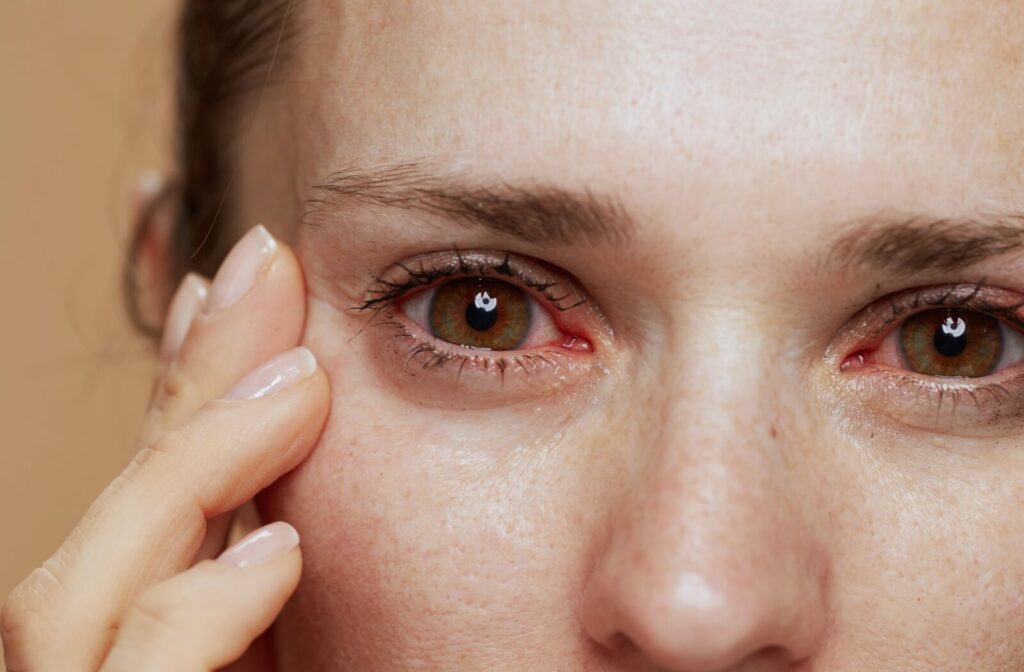If you’ve ever woken up with red, irritated eyes and immediately thought “pink eye,” you’re not alone. This common assumption often leads people to self-diagnose or seek quick fixes without understanding what’s really happening.
The truth is, several eye conditions can masquerade as pink eye, such as:
- Dry Eye
- Allergic Conjunctivitis
- Blepharitis
- Stye or Chalazion
- Corneal Abrasion
This innocent misunderstanding can lead to improper treatment and worsening discomfort, which an accurate diagnosis from your optometrist can prevent.
Pink Eye Defined
Pink eye, medically known as conjunctivitis, is an inflammation of the conjunctiva—the thin, transparent membrane that lines the inside of your eyelid and covers the whites of your eye. When this tissue becomes inflamed, it causes the characteristic redness and irritation we associate with pink eye.
There are 3 main types of pink eye:
- Viral conjunctivitis
- Bacterial conjunctivitis
- Allergic conjunctivitis
While allergic conjunctivitis technically is a type of pink eye, it’s the bacterial and viral strains that people usually worry about. These forms are highly contagious, and they spread quickly through families, schools, and workplaces. The visible symptoms—red, watery eyes with possible discharge—can be alarming and socially embarrassing.
Aside from redness, pink eye symptoms can also include:
- Light sensitivity
- A gritty or burning sensation
- Discharge (with bacterial pink eye)
- Difficulty opening the eyes, especially in the morning
- Temporary blurry vision from excessive tearing or discharge
While pink eye can cause temporary vision changes, it rarely causes permanent vision damage when properly treated. However, certain severe cases—particularly bacterial infections—can lead to complications if left untreated.
Most cases of pink eye resolve within a few days to a week with the right treatment—which is why accurate diagnosis is so important.
Pink Eye or Something Else? Common Misdiagnoses
Here’s a fascinating fun fact: shark corneas are surprisingly similar to human corneas—so much so that they’ve even been used in human corneal transplants.
While that’s a wild piece of eye trivia, it’s a reminder of how complex and delicate our eyes really are. That’s why conditions like dry eye, allergic conjunctivitis, or blepharitis can sometimes be mistaken for pink eye—because many eye issues share similar symptoms but require different treatments.
Dry Eye
Dry eye occurs when your eyes don’t produce enough tears or when they evaporate too quickly. This can cause redness, irritation, and a gritty sensation, all of which closely mimic pink eye symptoms.
That said, dry eye usually affects both eyes at once, while pink eye may start in one eye. Dry eye symptoms often worsen throughout the day, especially after long hours on the computer or if you’re living in a dry place. The discharge in dry eye is usually minimal and stringy, unlike the thick discharge often seen in bacterial pink eye.
Allergic Conjunctivitis
Although allergic conjunctivitis is a type of pink eye, it’s different from the contagious strains people worry about. You can’t catch allergies, so manage this allergic reaction with artificial tears and oral antihistamines.
Allergic conjunctivitis typically affects both eyes simultaneously and is often accompanied by other allergy symptoms like sneezing, runny nose, or skin reactions. The itching is usually more intense than in infectious pink eye, and symptoms often correlate with exposure to specific allergens or seasonal changes.

Blepharitis
Blepharitis is inflammation of the eyelids that affects the area where eyelashes grow. This condition can cause symptoms that overlap with pink eye, such as redness, crusting around the eyelashes, and watery eyes.
Blepharitis primarily affects the eyelid margins and lash line, while pink eye affects the conjunctiva. With blepharitis, you’ll notice more crusting and flaking around the eyelashes, while the eyelids themselves may appear red and swollen.
Stye or Chalazion
A stye is a painful, red bump on the eyelid caused by a blocked oil gland, while a chalazion is a larger, usually painless bump caused by a blocked meibomian gland. Both might be mistaken for pink eye because of redness, swelling, irritation, and possible tearing.
What separates styes and chalazia from pink eye is the distinct bump that develops on the eyelid, and the redness surrounding it.
Corneal Abrasion
A corneal abrasion is a scratch on the cornea, often caused by foreign objects, contact lenses, or rubbing the eyes too roughly.
Corneal abrasions typically cause more severe pain than pink eye, especially when you blink. It may feel as though something is stuck in your eye. Unlike pink eye, corneal abrasions usually affect only one eye and have an apparent cause.
An Accurate Diagnosis: Why It Matters
Getting the right diagnosis for your eye symptoms isn’t just about convenience—it’s about protecting your vision. Though the intention is always in good faith, self-diagnosing your symptoms for pink eye can do more harm than good.
The primary concern is that we delay the right treatment.
Let’s say you think you have pink eye, when in reality, dry eyes are the culprit behind your redness and excessive tearing. Treating dry eye with antibiotics (thankfully, you’ll need a prescription for those) won’t be very helpful. Conversely, if you have bacterial pink eye but treat it as if it’s viral, the infection could worsen or spread to others.
On top of that, the underlying condition mimicking pink eye might go untreated. While some causes of this are more mild than others, the persistent discomfort that accompanies a self-diagnosis gone wrong is never pleasant.
This is precisely why an accurate diagnosis matters. As optometrists, we have the tools and knowledge to distinguish between different eye conditions. Treatment begins as soon as we determine the condition behind your symptoms.
Find Relief with an Accurate Diagnosis
While it’s natural to try to self-diagnose minor ailments, eye symptoms deserve careful attention because your vision is irreplaceable.
If you’re experiencing persistent red, irritated eyes, don’t assume it’s just pink eye. Schedule an appointment with our Focus West Optometry team for an accurate diagnosis and treatment plan.
Remember, when it comes to your eyes, it’s always better to be safe.



